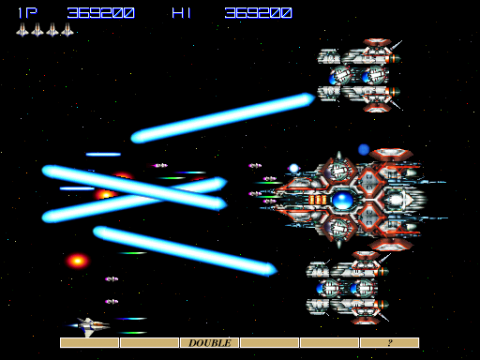
But for Gradius V, Multiples can do more than follow your ship, they can be controlled separately in four different configurations. (Japanese gamers had this luxury when Gradius Gaiden was released for the PS1 in 1996) In addition, as a radical change from past titles, when the Vic Viper is destroyed, you are not sent back to a checkpoint, but by taking a cue from the Salamander series, you respawn where you left off, and are able to pick up your stranded Multiples.However the biggest change in the gameplay is the new Multiple Control.īefore, Multiples hollowed the Vic Viper in a set formation based on weapon selection. First off, this is the first US-based Gradius title to support two player simultaneous play. Also we have the common "Shoot the Core" bosses that we have been accustomed to since the first game.īut Gradius V has a few surprises of its own. We still have the classic side scrolling and the collection of capsules used to boost up a power meter with six different items: Speed Up, Missiles, Double Guns, Lasers, Multiples (also known as Options), and Force Fields.
#Gradius gaiden hardcore gaming series#
Most of the gameplay from the original series is left intact. A little bit of originality in the series would be helpful, and thanks to Treasure, that originality has been added for Gradius V. Everything about the game was a rehash of Gradius 3 with only 3D graphics: the dragon-infested planets, the volcanic stages, the heads from Hell known as the Moai, the turbo maze, the boss rush before the main base, and of course, the insanely easy end boss. Gradius 3 on the Super Nintendo was always a personal favorite of mine, but when Gradius IV came out, it was somewhat of a disappointment. Then the series slowed down until 1995, when Salamander 2 was released to Japanese arcades along with Gradius IV in 1998. Gradius 3 was released first as a nearly impossible arcade title in 1989, and then into a much easier and more enjoyable SNES cart in 1990. As for US gamers we received the spinoff series Salamander (also known as Life Force). We were first treated to Gradius 1 in 1985, and Japanese gamers got the honor of playing Gradius 2 in 1988. We’re talking about a series that is almost 20 years old (more if you include Scramble into the mix).

After all, we are talking about one of the oldest but most loved shooter franchises ever. When Konami announced Gradius V for the PlayStation2, shooter fans like myself were ecstatic. Sure they made some disappointments such as Silpheed 2 and Mischief Makers, but most of the time Treasure was known for quality.

Later on in their career, Treasure also developed what many consider to be the best shooter of all time, Radiant Silvergun on the Sega Saturn.

After leaving Konami, they formed Treasure and their first release is what I consider to be one of the greatest games of all time, the heavily underrated Sega Genesis classic Gunstar Heroes. Interesting enough, they were formed by several former employees of Konami, and during their SNES era they created some of the best games made for that system: Contra III, Super Castlevania IV (which I to this day believe is the best Castlevania before Symphony), and the unforgettable Axelay (which sorely deserves a sequel). One of the best shooter developers is a company called Treasure. Yes, it’s believed that Konami’s 1981 Scramble was the very first side scroller, but according to Gradius Galaxies on GBA, it is part of the Gradius series. For a time, I memorized the patterns of the best series available: Thunder Force (5 was a masterpiece), R-Type, Aleste, and of course the one that started them all, Gradius. I always have a love for classic 2D shooters, and even today, thanks to the power of emulation, I always go back to playing the best shooters.

During that time, although being limited in supply, 2D shooter fans were treated to masterpieces such as R-Type Final, Contra: Shattered Soldier, and the insane Mars Matrix (which I recently had the chance to play thanks to MAME). For the last few years I have heard the same bull about the 2D shooter being a dying genre now that 3D has taken over. Whoever says that classic shooters are dead should be subjected to Gradius V.


 0 kommentar(er)
0 kommentar(er)
